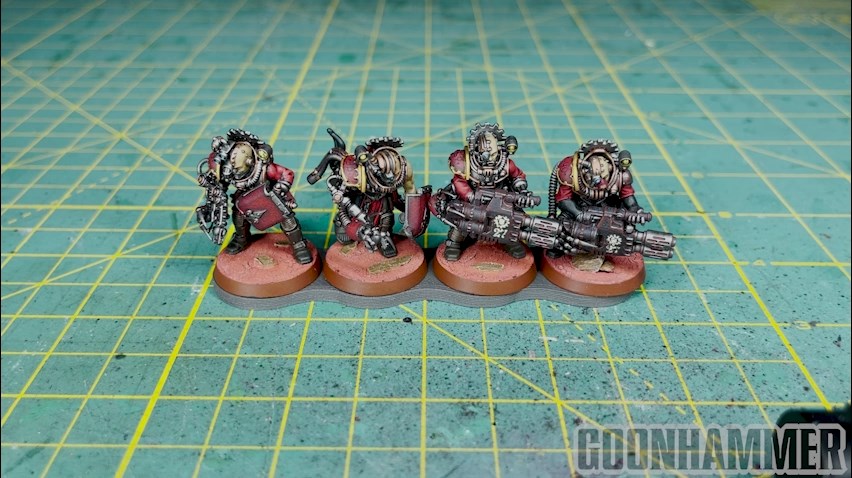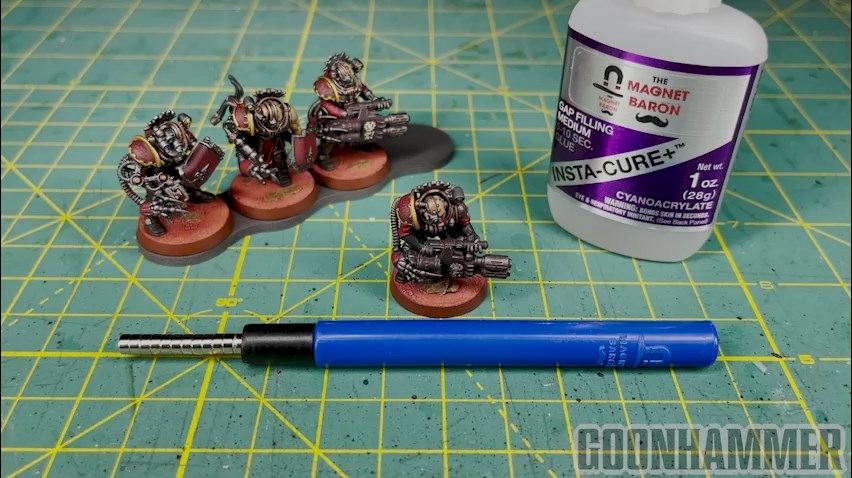Magnet Baron has provided us material for this review, however the contents of this review represent our unbiased opinions. When putting this review together we approached Magnet Baron, not the other way around, because we were so interested in covering their products.
It was the best of times, it was the worst of times, it was the age of individually moving a hundred models across the battlefield, it was the age of foolishness.
There are frequently tactical and nuanced decisions to be made when moving models around the table – getting line of sight, tucking into cover, having the perfect two-rank spacing for optimal position. However, just as frequently you want to grab a snow shovel, scoop everything up, and drop it off 6″ forward. This isn’t bad with a handful of models, but if you play an infantry-heavy or horde army, then you know how much time that can burn.
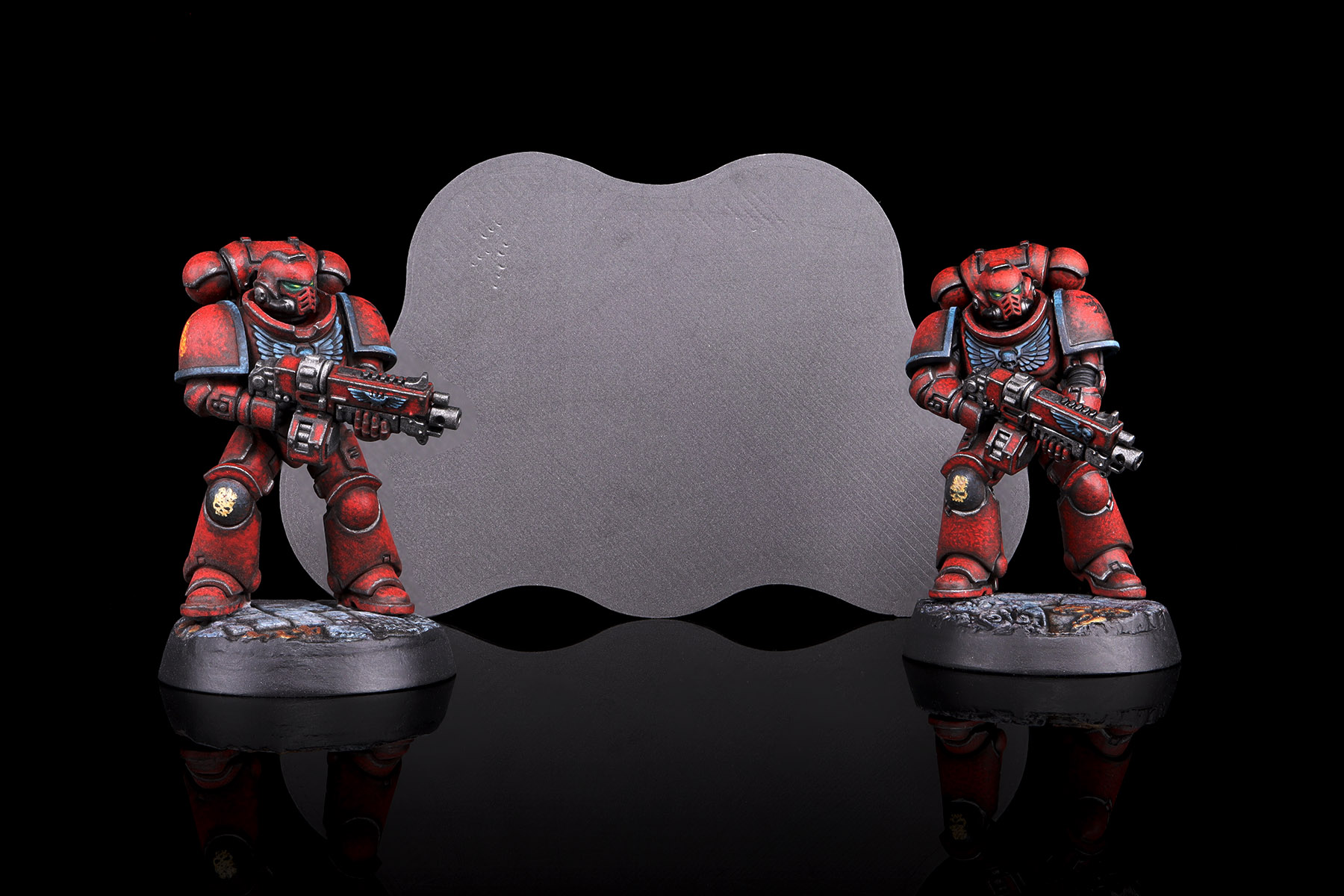
Movement trays come to the rescue. All your models hop on their slick surfboard and scoot around the table. Problem solved, and other problems introduced. Many traditional movement trays have individual slots for each model. This is a reasonable way of designing a product, but there are practical issues with it – the slots lock you into how you can arrange your models, and they aren’t as densely packed as they could be (which can be important for games with variable-range melee or base-to-base rules).
Additionally, traditional movement trays aren’t known for their stability. Tilt the tray a little too much, or bump it the wrong way, and you’ll be spilling them faster than the internet man holding too many limes.
For those reasons and more, the movement trays from Magnet Baron caught our attention. Unlike other trays, these are made with a ferrous material which, if you magnetize your model’s bases, means you get a low-footprint, durable, movement tray that your models stick to by the power of the ELECTROMAGNETIC FORCE. That’s science, baby, and you don’t even have to talk to no scientist.
And what’s more scientific than a peer-reviewed review? Three peers, to be precise, as we’ve got three reviewers who have been putting these movement trays through the ringers, and are here to weigh in on their experiences.
Pendulin
Seeing an army with a hundred Skitarii brings joy comparable only to the dread of actually playing an army with a hundred Skitarii. I can’t help it. I love these little cyborg weirdos, and want to take piles of them in every game. But packing, transporting, and moving dozens of these fragile, spindly, servants of the machine god is an exercise in pain. I cannot count the number of antennae I’ve broken by simply brushing up against these models, nor the amount of time I’ve burned by having a movement phase stretch on and on.
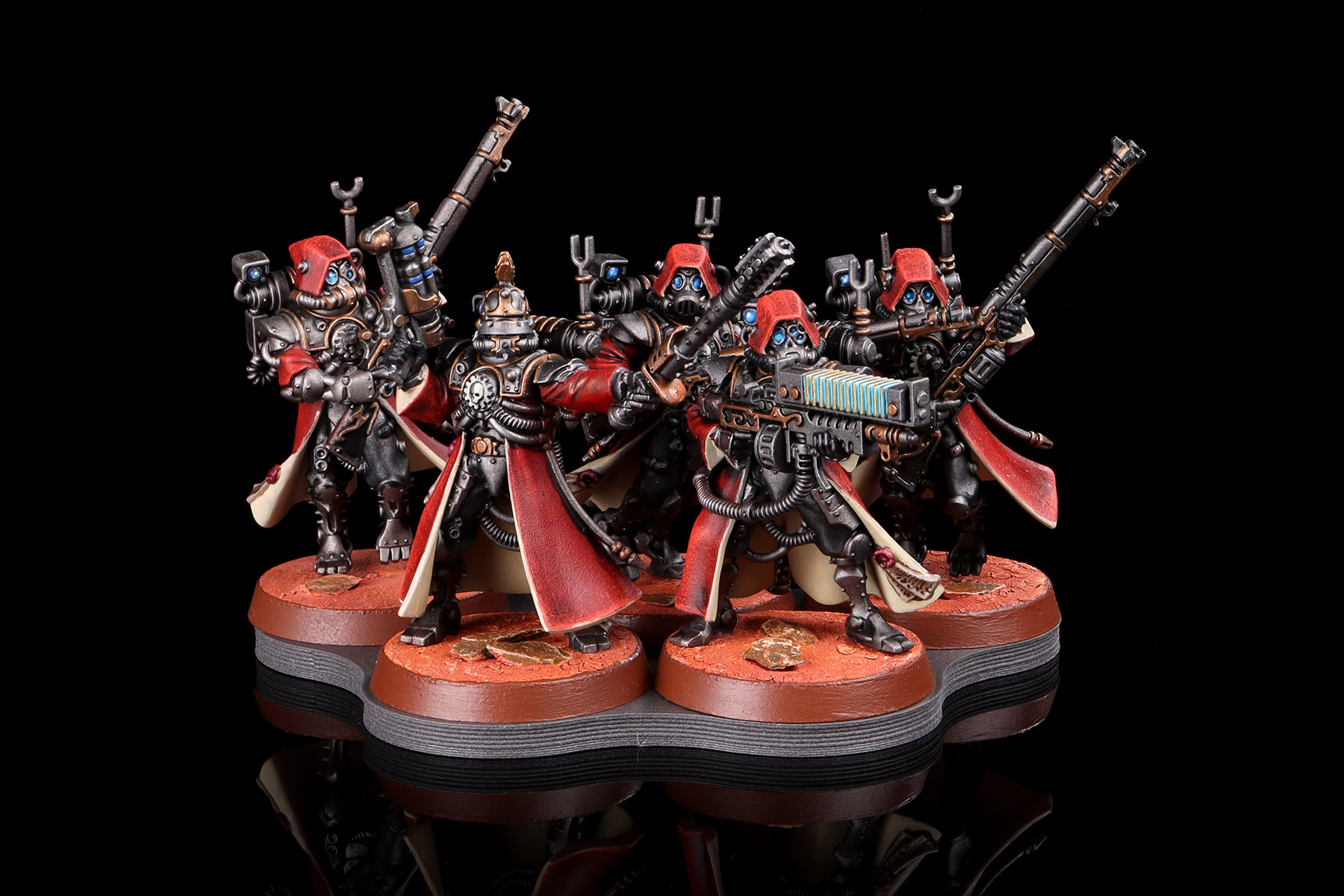
Magnet Baron’s movement trays seemed like a perfect fit for me. For years now, I’ve been magnetizing the bases on each of my models to make transporting them easier, so I was already prepared. I just had to unbox the movement trays, slap on some models, and I was good to go.
My first impressions were quite positive. I’m ignorant of material science, but the trays are made of some sort of plastic that feels sturdy and durable. They’ll stand up to rough handling without issue. I expect the plastic has iron or some other ferrous material mixed in, but you can’t tell from looking at it or holding it.
There are noticeable 3D print lines on the bottom of the tray. I initially thought this was a bit annoying, but having used these trays in about ten games so far, I’ve changed my mind to consider it a feature. The print lines give the bottom of the tray a pleasant texture that has some practical benefits.
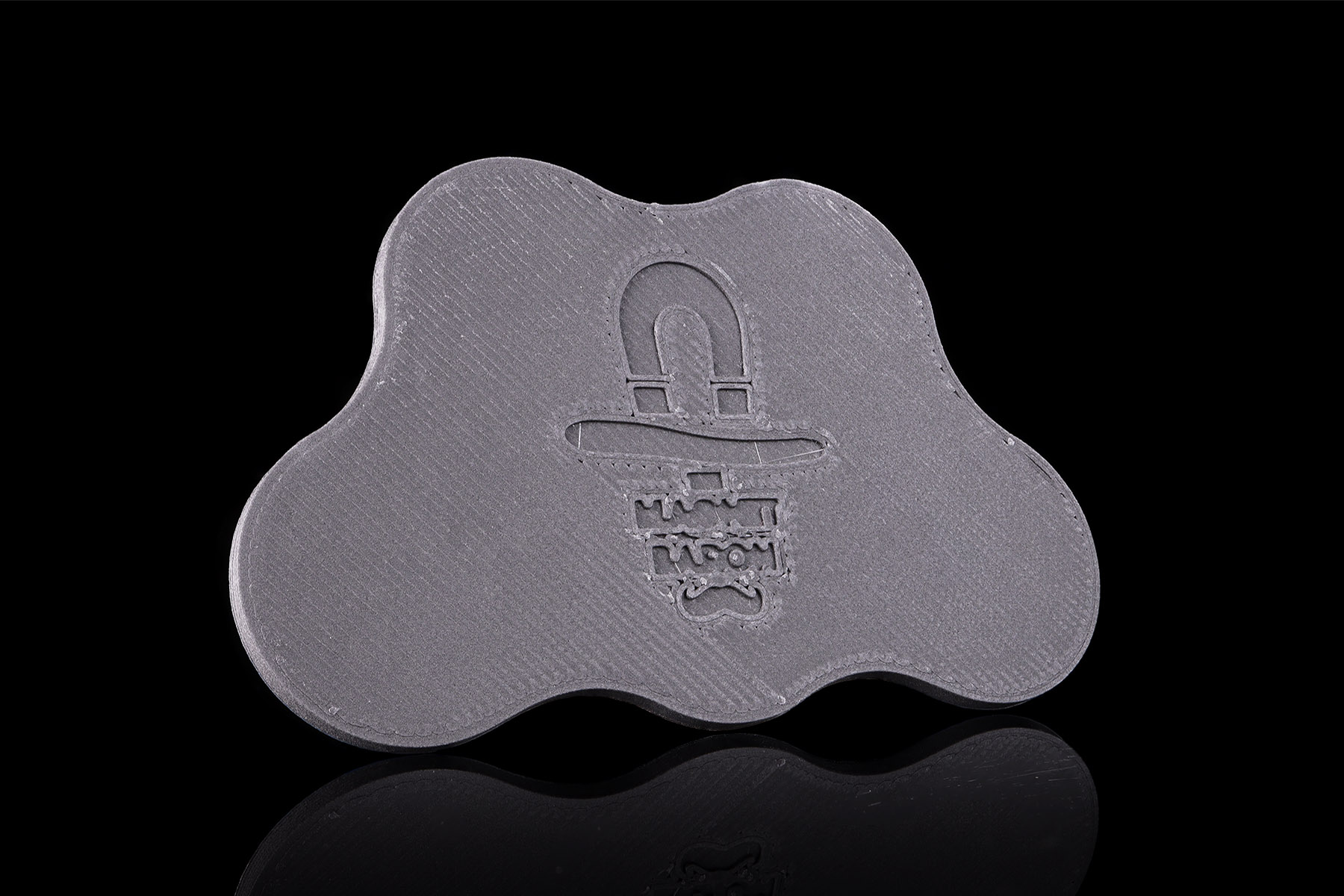
The bottom of the tray has a little bit of grip – just enough to prevent it from sliding around a neoprene game mat if you bump the table, but not enough that makes sliding the tray difficult. I was worried this texture would catch on loose threads, but I’ve yet to have that happen. At a cosmetic level, the texture actually makes these trays feel even more rugged. The plastic is plenty durable on its own, but something about the texture on the bottom makes the tray feel like it’s especially durable.
On the other hand, the top of the tray is smooth as can be. No chance that it’ll scuff or scratch your bases. You can see the diagonal print lines in the above picture, but that’s largely due to lighting and it being an incredibly high quality picture (wow, I bet the photographer is a handsome and savvy dude). In person, the trays look and feel glassy smooth.
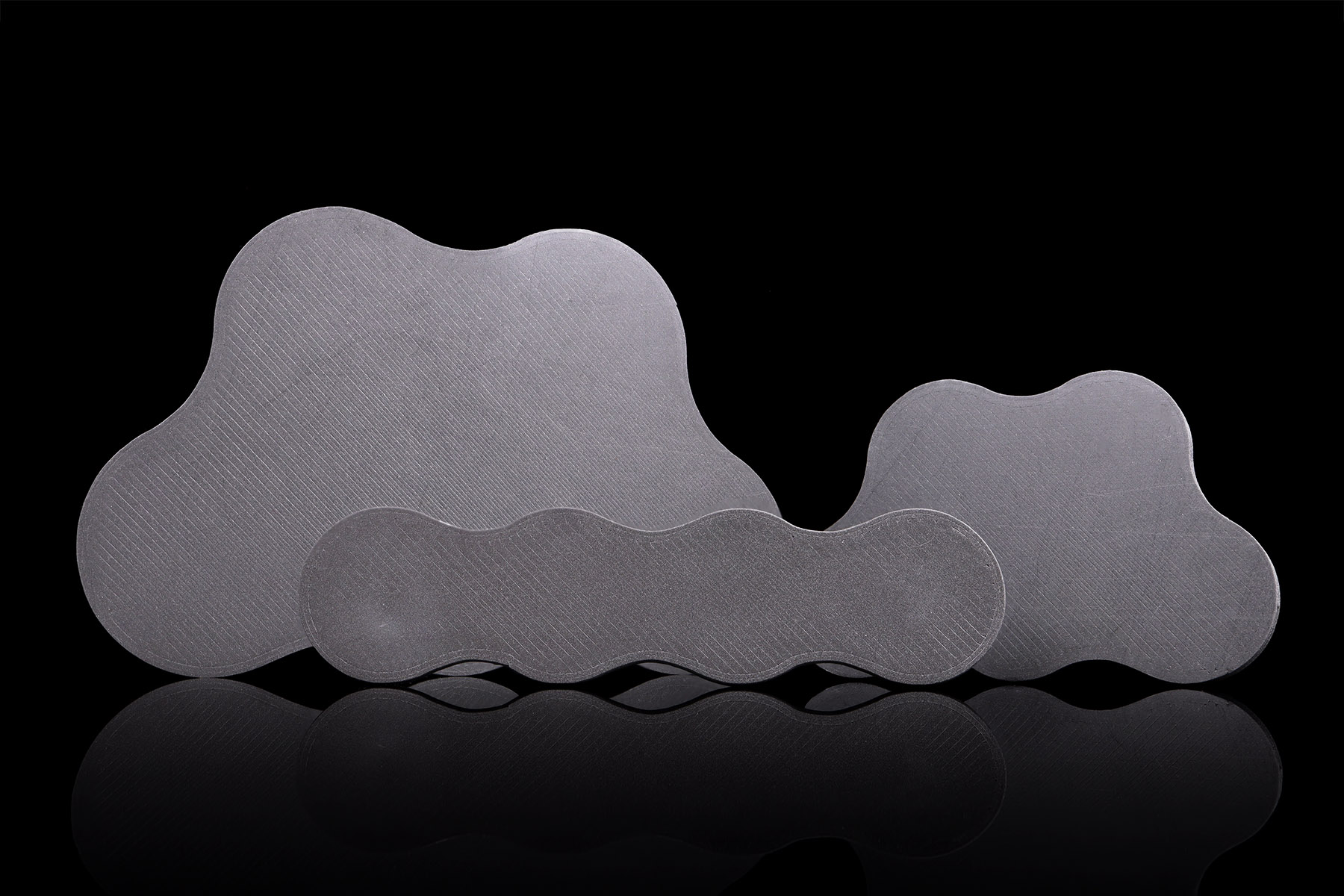
With cosmetics out of the way, how do these trays perform? Quite well, in fact. Models adhere to them surprisingly well, and it makes moving them around the battlefield a breeze.
Given that I have hundreds of models that already had magnets glued to their bases, my primary concern was that those magnets would either be too weak or too strong. Fortunately, that wasn’t the case for the most part. For years now, I’ve been burning through an absolutely massive stack of 1/4″ x 1/16″ N42 magnets I bought, one per 25mm base, one or two per 32mm base, and then more for larger bases. These magnets work great for these movement trays.
If your models aren’t already magnetized, then Magnet Baron sells everything you need. Of course you can get magnets from anywhere, but it’s extremely convenient to grab all this from one place and know that the magnets are the right size, shape, and strength.
Those servitors are on 25mm bases and I used Magnet Baron’s 4.5×2.2mm N52 magnets and you can see they’re plenty strong. For 32mm bases, Magnet Baron recommended either 4.5×2.6mm or 6×2.6mm magnets, and for larger bases it scales up. Notice that the 32mm magnets are 0.4mm thicker – that’s intentional. Magnetic attraction is inverse squared, which means the pull of a magnet decays very quickly as they get separated. Because 32mm bases are just a little bit deeper than 25mm bases, Magnet Baron recommends using a slightly thicker magnet to compensate. It’s something I hadn’t thought of before, and it’s nice to see that attention to details.
For attaching the magnet to the base, I’ve always just used a dollop of superglue, and rarely had issues with the magnet coming off. Magnet Baron mentioned that if you scuff the surface of the magnet, it gives the superglue more surface area to grab onto and helps with adhesion. Seems like solid advice.
Magnet Baron also has a handy tool, Magnicators, that blue stick in the video above which helps me track which end of the magnet is which. It comes in a two-pack, one red and one blue, each for a different magnet polarity. It’s kind of superfluous hobby tool, not necessary by any means. But I gotta say that it’s actually pretty convenient. Firmly in the “really good stocking stuffer” class of hobby tools. If you’ve ever found yourself stacking a dozen magnets on a model’s head to track which end is the right polarity, then a Magnicator might be up your alley.
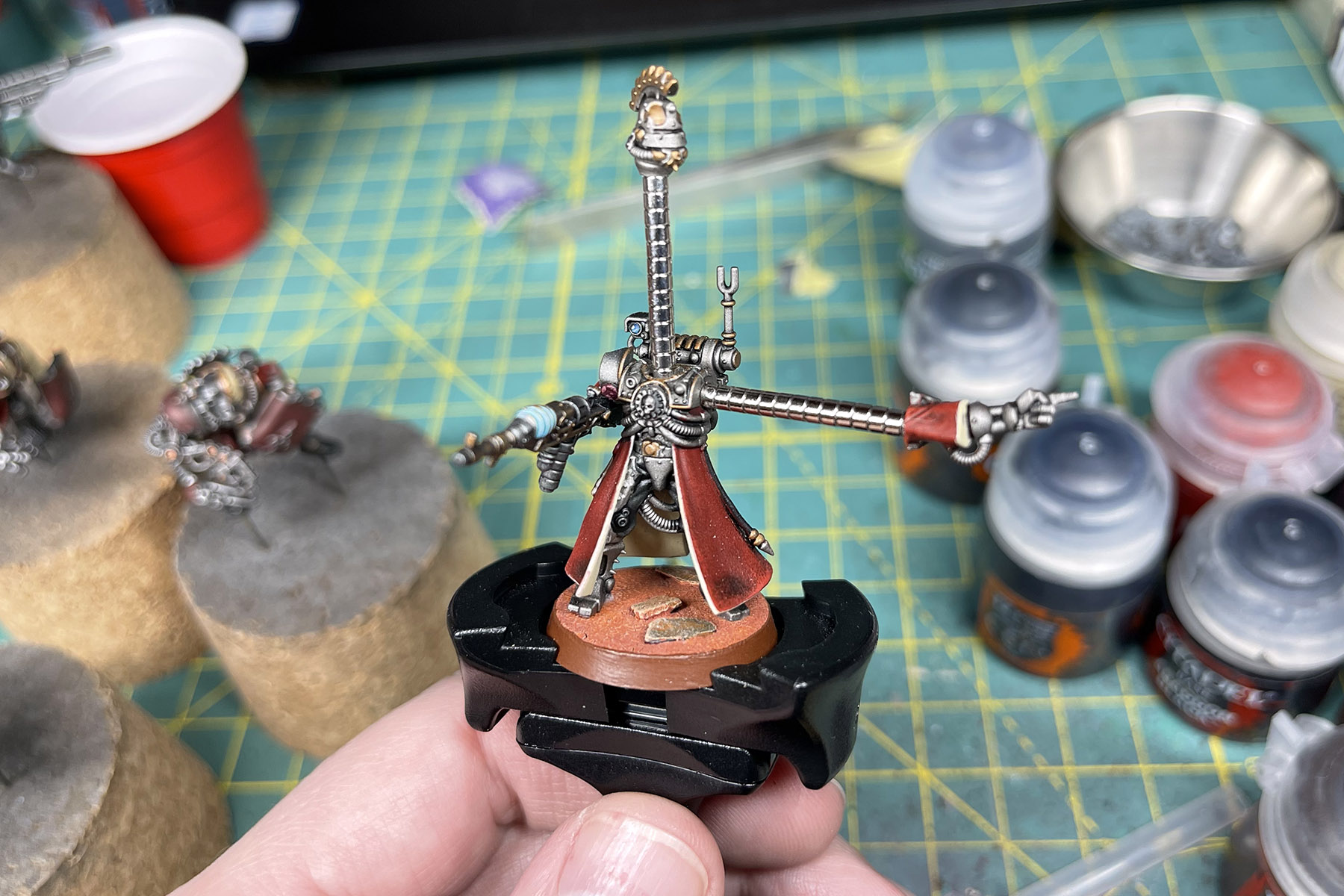
It’s not all sunshine and magnetic roses, though. I’ve got a couple models that absolutely do not work with these movement trays, but that’s not so much a fault of the tray, as it is a fault with my own dumb past-self. They were some of the earliest models I magnetized, and I used magnets that were incredibly weak. So weak that they don’t even stick to the travel case I use to transport my minis. It turns out when you use weak magnets, that they don’t stick to things, who knew?

To see these trays in the field, I took them to Games Workshop’s Grand Narrative and they were a big help. I was using trays that held 5 models each, and moving 20 Skitarii was as quick as measuring 6″, sliding the first tray into position, and sliding the other trays right behind it. If only my Command Phase was that quick.
As games went on, I began noticing a pattern. By the time the game hit round 3, I found myself needing to break apart my clumped-up infantry into very specific positions. One model toe-ing into cover, another tapping an objective, stuff like that. In those cases, these trays worked against me. I was frequently found myself making good use of the trays in the first turn or two, but not needing them to finish out the game.
Even if I wasn’t using the trays for the entire course of the game, they were still a great help when I needed them. And I wasn’t even using the self-adhesive magnetic sheets that turn these ferrous trays into proper magnetic trays. But I’ll leave that to Bair, and speaking of …
Bair
Stone Gauntlet Phalanx Warders. Imperial Fist players (and their opponents) of Horus Heresy will know exactly what I’m talking about here. Units of 10+ space marines kitted out with massive breacher shields and power axes (and bolters) running around the table in base-to-base contact to be nigh on unkillable. Not just base-to-base but in contact with at least 2 other models from the unit. Thematically this sounds cool to an Imperial Fist player (less so for their opponents, maybe) but is physically a real pain to keep together when moving 7” every turn and charging. And if you want to run this in your army? You’re going to need at least 2 units of 10+ dudes in this formation.

Now if you have nice friends they might not care if you keep this formation exactly right all of the time for the ease and speed of play; but when you’re playing pick up games or at an event it’s best practice to do it the “right” way all the time. I’ve been using the 32mm cloud shape for these guys and definitely speeds up play when moving around little bricks of infantry forming a literal wall.
Separate from the trays you can buy self-adhesive magnetic sheets so you can use them with magnetic cases. I tote my armies around in A Case magnetic cases so being able to have the models on the trays in the case is a massive bonus – it doesn’t waste any space needing to keep the trays separate and the models are already on the trays ready to use. I’m not saying it saves you hours of time, but cutting down on any setup before a game is great, especially at an event when time is already at a premium. I mean, that’s really why we’re using these at all – to save some time and effort to do more gaming and less fiddly moving.

I had been using N52 6x2mm magnets on the underside of my bases since I started magnetizing them a year or so ago but the 4.5×2.2mm Medium ones are under those marines and work just as well, if not a bit better. Just a bit of super glue and easy done (I also use some super glue activator spray because I’m very impatient). They’re plenty strong to keep the models magged to the tray and also on their own in my magnetic storage boxes (Really Useful Boxes with A4 sheet of magnetic sheet) and to the magnetic trays of my A Case:


Overall I’m really happy with these trays. If you’re running loads of infantry that can be clumped up, at least at the start of your games, they’ll save you some time for sure. They work well, feel very solid, and aren’t distracting in any way on the tabletop.
Ellar
I decided to take these bad boys on a trial by fire and used them for two different Age of Sigmar tournaments for my Kruleboyz. While I won’t be bragging about my actual tournament performance, I am happy with the performance of the little trays my Orruks rode around on. I’ve previously used MiniMagTray movement trays for my models, but after some time with the Magnet Baron equivalents I am pleased to say I’ll be swapping over to the Baron’s version for a few good reasons.
Firstly, the height of the trays are a little bigger, which means it’s much easier to pick up the tray itself rather than just fat finger it and grab the model’s base instead. I’ve lost count of the amount of times I’ve simply tugged one end of the tray up into the air awkwardly and sent models flying because I didn’t have a good grip. It might seem like a minor thing, but with Age of Sigmar being much more combat focused than its futuristic cousin, there are a lot of times where I will need to interact with the trays themselves – removing casualties in a large scrum for example. That added height and the textured side just makes the process a little easier. It’s still clumsy, but that’s more down to how much a typical AoS model overhangs and certainly isn’t the movement tray’s fault.
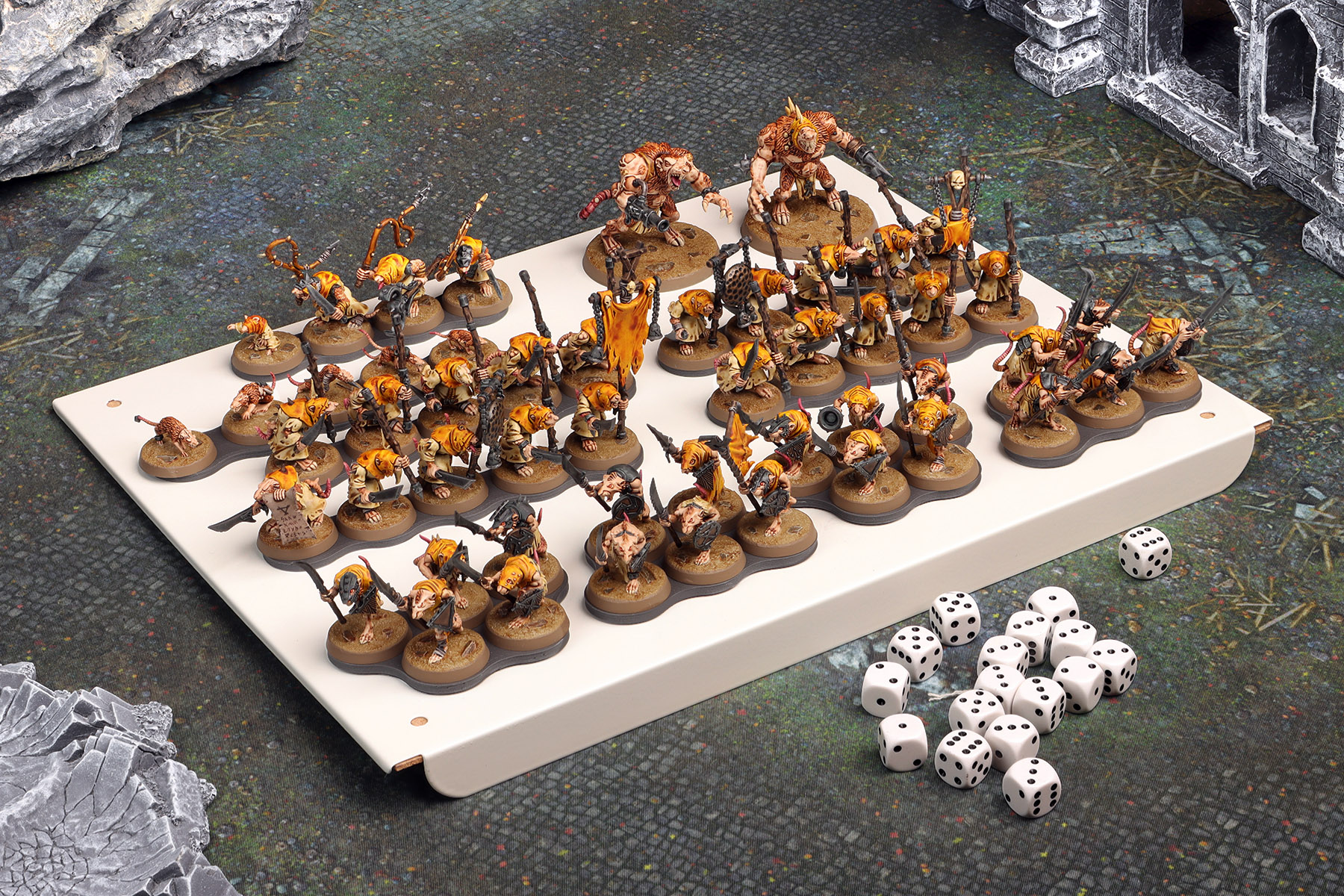
Secondly, I appreciate that they (optionally) offer Flex Adhesive Trays that are cut to fit the Trays they attach to snugly. As someone who carries my armies around in a KVISSLE Letter tray, being able to magnetize the MB trays themselves is fantastic as it means I can store my army ready to be deployed neatly, ready to be put in perfect position come the beginning of deployment. It is an additional cost, but one I appreciate because it gives you a greater degree of flexibility in transportation and as they are cut to fit flush they don’t disrupt the aesthetic or the mechanics of the operation of the trays at all.
Operation isn’t flawless however, because similarly to Pendulin’s comments, it can be awkward to use the trays when it’s combat time and you need to make some creative pile in moves to get as many models in position to attack as possible. That’s not a criticism I’m leveling at this particular movement tray, but more an observation for people new to movement trays and wondering how they operate in real game settings. You’ll often find yourself simply pulling them off the trays if you expect a prolonged combat because they become counterproductive for model placement if they keep snapping back into a rigid formation you don’t want.
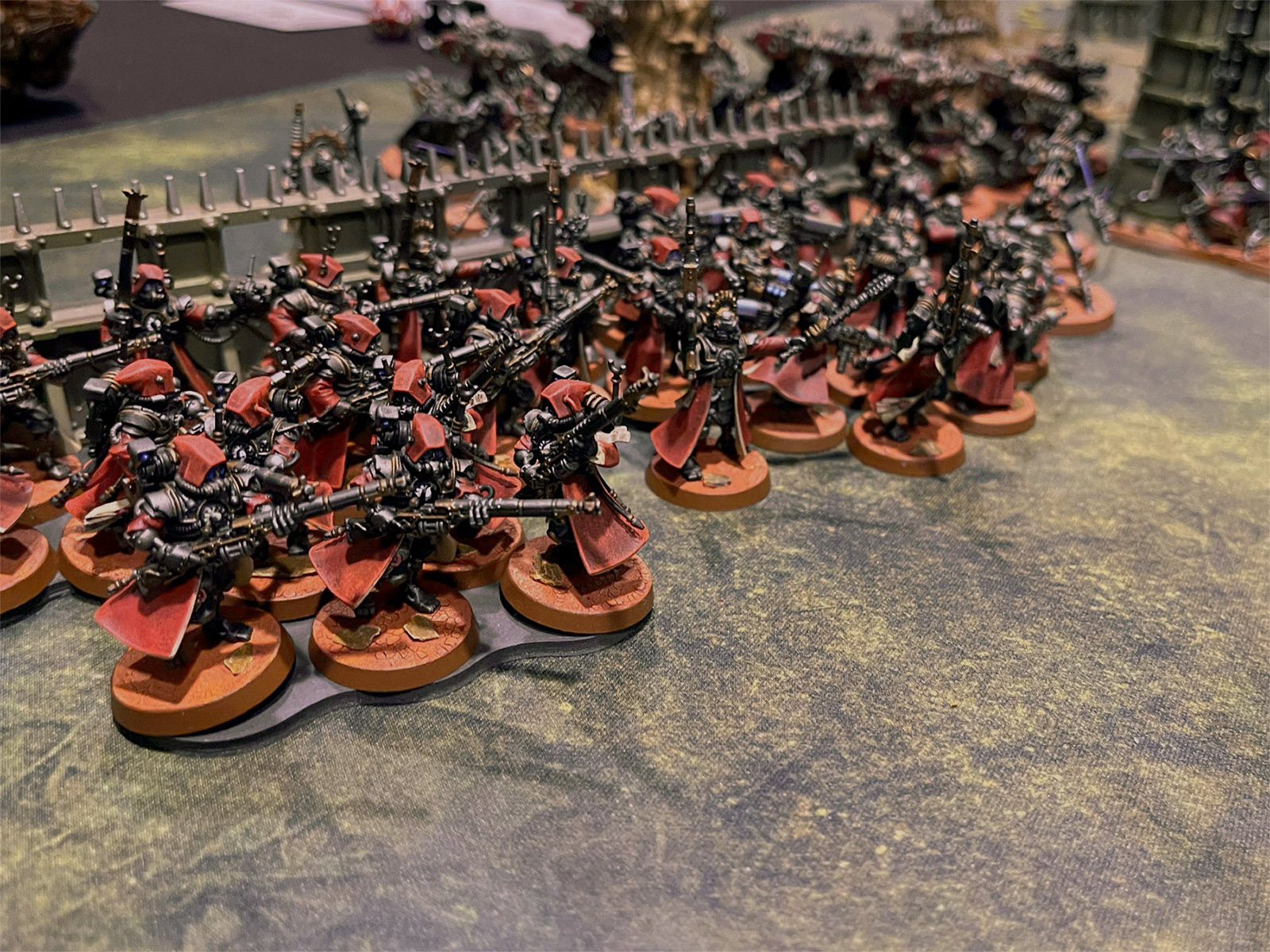
They offer different sizes based on (you guessed it) the base size of the models you want to tray up – I used straight line trays for 25mm Hobgrots, and cloud trays for my 32mm Gutrippaz. I think they work out a little better for 25mm chaff infantry that you expect to die in bulk and where pinpoint pile-in’s aren’t as necessary, but I would happily continue to use them for my larger Gutrippa squads as well, who can sometimes run up to 30 32mm models in a group at a time. As my other primary army is a Nighthaunt horde – their function for 32mm models in particular was of keen interest to me!
Final Thoughts
Magnet Baron’s movement trays offer a unique way of improving your games: speeding up mass troop movement without interfering with close-quarter measurements and, if you use the adhesive magnetic stickers, can double as transport trays. Being able to grab a fully loaded tray from your transport case and drop it right on the battlefield is incredibly convenient.
Even if you don’t use them for the entire duration of the game, the up-front time savings can be significant, especially if you are playing multiple games in rapid succession. And anything that speeds up the drudgery of moving a million tiny plastic models gets a thumbs-up.
Are Magnet Baron’s Movement Trays right for you? That depends on what army you play, how you play them, and what parts of the game you want to speed up. They aren’t silver bullets – there are plenty of situations where these movement trays aren’t right for a particular player or army, and I doubt you could slay a werewolf with them. But if you’ve stuck with this review this long, then you know what kind of player you are, and you also know whether or not these trays are for you. For us here at the Goonhammer Corporate Headquarters, they’re a big hit and will be a staple in our hobby bags.

